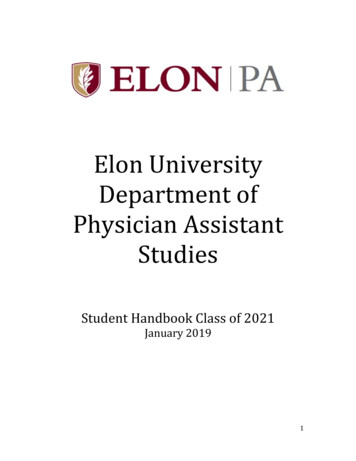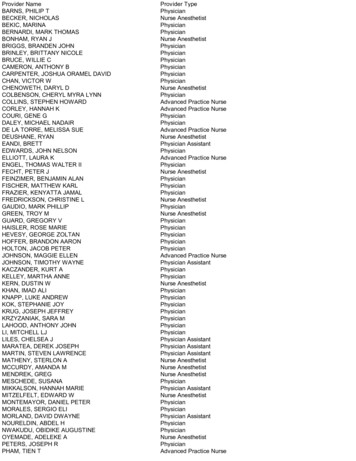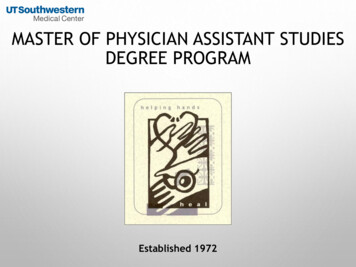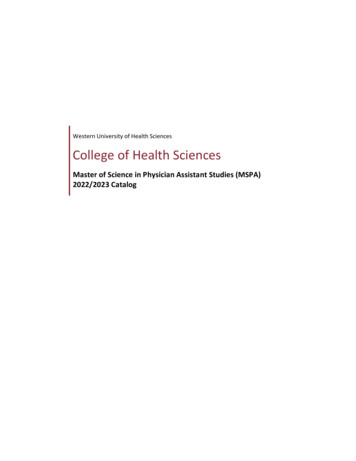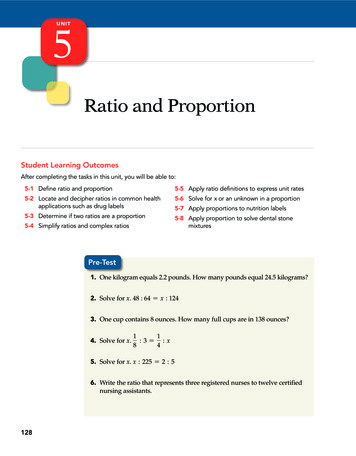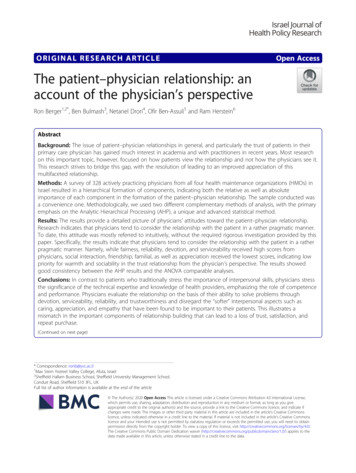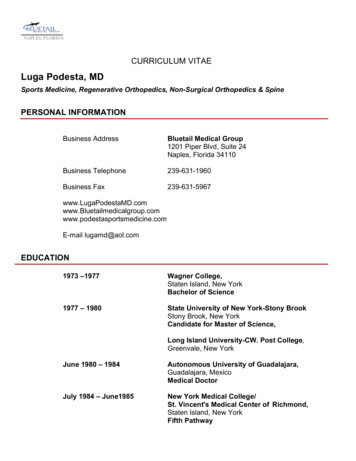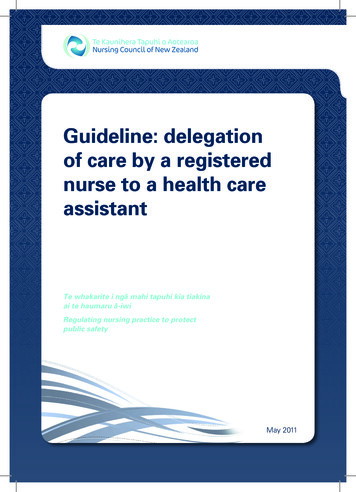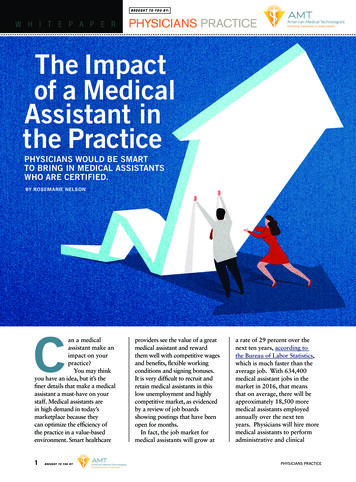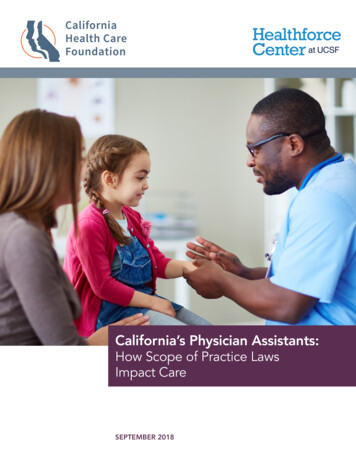
Transcription
California’s Physician Assistants:How Scope of Practice LawsImpact CareSEPTEMBER 2018
ContentsAuthorsTimothy Bates, MPP, is an analyst at the PhilipR. Lee Institute for Health Policy Studies atUCSF. Joanne Spetz, PhD, is associate directorof research at Healthforce Center at UCSF. Sheis also a professor at the Philip R. Lee Institutefor Health Policy Studies, Department of Familyand Community Medicine, and the School ofNursing at UCSF. Miranda Werts is a researchintern at the Philip R. Lee Institute for HealthPolicy Studies at UCSF.AcknowledgmentThe authors thank Kristine Himmerick, PhD, PA,for providing information included in this brief.3 Overview of the ProfessionPhysician Assistant EducationPractice Oversight of Physician Assistants in CaliforniaCollaboration LimitsCosignatory RequirementsComparison to Other States5 Examining the Evidence for Practice Expansion:A Summary of ResearchAccess to CareQuality of CareCost of Care7 AppendicesAbout Healthforce Center at UCSFA. The Landscape of Physician AssistantsHealthforce Center at UCSF prepares healthcare organizations for success by combining adeep understanding of the issues facing theirworkforce with the leadership skills to driveprogress. They work with foundations, hospitals,delivery systems, organizations, and individualsto ensure more effective health care deliveryand to inform health care policy. Their effortsare focused in the core areas of leadership programs and workforce research.B. P hysician Assistant Scope of Practice Elements,by State, 201811 EndnotesABOUT THIS SERIESLearn more at healthforce.ucsf.edu.About the FoundationThe California Health Care Foundation isdedicated to advancing meaningful, measurable improvements in the way the health caredelivery system provides care to the people ofCalifornia, particularly those with low incomesand those whose needs are not well served bythe status quo. We work to ensure that peoplehave access to the care they need, when theyneed it, at a price they can afford.CHCF informs policymakers and industry leaders, invests in ideas and innovations, andconnects with changemakers to create a moreresponsive, patient-centered health care system.This paper is one of a series that examines the scope ofpractice of selected California health professions. Theseries looks at professions discussed by the CaliforniaFuture Health Workforce Commission and its subcommittees and workgroups during spring and summer of2018. Each brief begins by describing the profession,including its legally permissible scope of work, andeducational requirements. The brief then outlines howCalifornia’s permissible scope of practice compareswith that of other states and provides a summary ofresearch studies on the impact of the profession’sscope of practice on access to care, care quality, andcosts. Finally, it summarizes demographic characteristics, practice settings, and geographic distribution.Visit www.futurehealthworkforce.org to learn more.For more information, visit www.chcf.org.California Health Care Foundation2
Numerous studies find that physician assistants(PAs) provide high-quality care and are more likelyto practice in rural regions and with underservedpopulations. California’s restrictions on physician assistant practice create a barrier to growth of team-basedcare and to improvements in the efficiency of health careservices.This paper describes the regulations that govern thescope of practice for PAs in California and in other states,and summarizes recent research on how these lawsimpact care.Overview of theProfessionPhysician assistants are state-licensed health professionals who practice medicine in collaboration withphysicians and other providers, including diagnosingillness, creating treatment plans, and prescribing medications.1 The education and training that PAs receive allowsthem to occupy a wide range of clinical practice areas,including family medicine / general practice, emergencymedicine, surgical subspecialties, and internal medicinesubspecialties,2 and it significantly overlaps with medicaleducation.3Physician Assistant EducationDuke University founded the nation’s first PA programin 1965. It was a two-year program that was based ontraditional medical education, and it provided trainingfor individuals without prior health care experience. Thisapproach was expanded upon by the MEDEX programat the University of Washington in 1968, which focusedon training those who already had considerable healthexperience — in particular, returning veterans who hadbeen trained as medics. By 1974 there were MEDEX programs across the nation, and today all states have at leastone physician assistant education program.4PA education programs are offered at the master’sdegree level, and the vast majority now require priorhealth care experience and possession of a bachelor’sdegree for admission, although some programs offer acombined, accelerated bachelor’s and master’s degree.The curriculum includes instruction in basic medical sciences along with clinical rotations in medical and surgicaldisciplines, and students must complete at least 2,000hours of supervised clinical practice.5 PAs in California arelicensed by the California Physician Assistant Board andmust obtain a qualifying score on the Physician AssistantNational Certifying Exam, administered by the NationalCommission on Certification of Physician AssistantsHow Scope of Practice Is Modifiedin CaliforniaScope of practice laws establish the legal frameworkthat controls the delivery of medical services. Thereach of these laws encompasses the full rangeof licensed health professionals — ranging fromphysicians and physical therapists to podiatrists anddental hygienists. Scope of practice laws governwhich services each category of licensed healthprofessional is allowed to provide and the settingsin which they may do so.With few exceptions, scope of practice statutesare set by state governments. State legislaturesconsider and pass the statutes that govern healthcare practices. Regulatory agencies, such as medicaland other health professions boards, implementthe statutes through the writing and enforcement ofrules and regulations.Such laws and regulations vary widely from stateto state. Some states allow individual professionsbroad latitude in the services they may provide,while others employ strict limits. The nature of thelimitations can either facilitate or hinder patients’ability to see a particular type of provider, which inturn influences health care costs, access, and quality.California’s Physician Assistants: How Scope of Practice Laws Impact Care3
(NCCPA). Although PAs must take the certifying exam aspart of the initial licensure process, California does notrequire PAs to maintain NCCPA certification to practicein the state, but most choose to renew their certifications; the share of licensed PAs in California who are notNCCPA-certified is estimated to be less than 10%.6Practice Oversight of PhysicianAssistants in CaliforniaIn California, PA practice is regulated by the PhysicianAssistant Practice Act (Bus. & Prof. Code §§ 3500 etseq.), which establishes the Physician Assistant Boardwithin the jurisdiction of the California Medical Board,and sections 1399.500 et seq. of the California Code ofRegulations.7 These statutes define the requirements ofPA education and training, stipulate the authority of PAsto provide medical services (including the prescribing ofmedications), and define the structure of the collaborative relationship between physicians and PAs regardingsupervision and oversight.The American Academy of Physician Assistants (AAPA)outlined six key elements of a modern physician assistant practice act.8 These elements, which are meant toencourage practitioner accountability, allow PAs to practice to the fullest extent of their education and training,promote flexibility and efficiency at the practice level,improve health care access and quality, and reduce costs.States meet these six criteria to varying degrees; eightstates have a practice act that includes all of the elements. California’s PA practice act reflects four of the sixelements; the following two gaps represent opportunities for statutory reform.Collaboration LimitsThe first concerns limits on the number of PAs with whoma single physician may collaborate. The current ratio isa maximum of four PAs per physician and was definedin the California Physician Team Practice ImprovementAct of 2007 (AB 3, ch. 376); the previous ratio hadbeen two PAs per physician. The American Academy ofPhysician Assistants9 and both the American College ofPhysicians10 and the American Osteopathic Association11have adopted a formal policy position stating that physician-to-PA ratios should not be standardized, but ratherdetermined at the practice level and be reflective ofpractice and community needs.California Health Care FoundationCosignatory RequirementsThe second area for potential statutory reform concernscosignatory requirements, which function as the processby which physicians review PA medical decisionmaking.California defines cosignatory requirements for PAs andphysicians by statute, rather than allowing such requirements to be determined at the organization or practicelevel. However, the state enacted legislation recently(SB 337, ch. 536 of 2015) that provides an alternativemechanism for demonstrating physician oversight. Thelegislation was intended to reduce the administrativeburden of the review process and was supported by theCalifornia Physician Assistant Committee (CPAC).Prior to the passage of SB 337, physicians were requiredto review, countersign, and date a sample of at least 5%of a PA’s caseload within 30 days of treatment; this isstill an accepted mechanism for physician oversight ofPAs. As an alternative, SB 337 allows a PA and collaborating physician to conduct a monthly review (either inperson or electronically) of at least 10 medical recordsof patients who were treated by the PA, for at least 10months of each year. It is also allowable for a PA andcollaborating physician to use some combination of thenew monthly review process and the preexisting “samplecaseload” review mechanism. The new law also reducedthe review requirement for cases where a PA has prescribed a Schedule II drug from 100% to a sample of20%, provided the PA is prescribing per protocol and hassuccessfully completed an approved education courseon controlled substances.12Comparison to Other StatesA taxonomy of restrictiveness developed at GeorgeWashington University categorizes California among themiddle group of states: In terms of scope of practicerestrictiveness, there are 22 states less restrictive and 15states more restrictive.13 (See Appendix B for a schematicillustrating state-level differences in the adoption of eachpractice element.)4
Key Elements of a Modern PhysicianAssistant Practice Act Licensureas the regulatory term. Licensure, incontrast to “certified” or “registered,” denotesa higher level of scrutiny regarding professionalqualifications, in addition to vesting regulatoryauthority with the state. Fullprescriptive authority. The ability of PAsto prescribe all legal medications includingSchedule II–V controlled substances.of practice determined at the practicelevel. The ability of PAs and the care teams ofwhich they are part to determine what medicalservices the PA provides within the legal scopeof practice, rather than having to use a definedlist of services determined by statutory language or a state agency.Examining the Evidencefor Practice Expansion:A Summary of ResearchPhysician assistants are trained to provide medicalservices across a range of settings. Allowing them topractice to the fullest extent of their education and training is widely seen as an effective way to address issuesof health care access, quality, and cost. This section summarizes recent research on this interrelated set of issues. Scope Adaptablecollaboration requirements. Theability of PAs and physicians to determine howthey work together to provide medical care,without regulations such as requirements that aphysician be on-site. Cosignatoryrequirements determined at thepractice level. The ability of PAs and the careteams they collaborate with to determine when,and the extent to which, a physician signs offon a PA’s medical orders or otherwise reviews aPA’s medical decisionmaking. Numberof PAs a single physician may collaborate with determined at the practice level.The ability of PAs and their health care teams todetermine how many PAs can collaborate witha single physician, as opposed to having a limitimposed by statutory language.Source: American Academy of Physician Assistants.Access to CareThe statutory limit on the number of PAs a single physician may collaborate with can negatively affect access tocare. Such a cap limits the ability of health care organizations to expand to meet demand for services, particularlyas community health centers are increasingly reliant onPAs to provide care within tight budget constraints.14 Inaddition, PAs are more likely than physicians to providecare in rural areas and to low-income and underservedpopulations; supervision regulations can impede PAworkforce growth in these settings.15 Similarly, the chiefnurse practitioner officer for MinuteClinic has cited PA-tophysician ratios as one of the biggest issues limiting theuse of PAs to provide care in the retail clinic setting.16Quality of CareA body of research dating from the early 2000s indicatesthat PAs are providing care that achieves similar clinicaloutcomes to those produced by physicians. In addition,there is evidence that patients are increasingly comfortable and satisfied with the care provided by PAs.17 PAsplay important roles alongside nurse practitioners (NPs)in many outpatient and primary care settings, and thusresearchers often consider both in studies of quality ofcare. These studies have reported similar quality of care,service utilization, and referral patterns for physicians,PAs, and NPs in community health centers, and PAsand NPs were more likely to provide health education.18Research in the VA health care system has reportedsimilar quality of care in the treatment of diabetes andcardiovascular disease.19 House calls conducted by PAsfor cardiac surgery patients have been shown to reduce30-day readmission rates by 25%.20California’s Physician Assistants: How Scope of Practice Laws Impact Care5
A number of studies have examined the quality of careprovided by PAs in hospital settings. One reported thatincreasing the number of PAs on hospitalist care teamshad no effect on clinical outcomes and resulted in a lowercost of care;21 similarly, pediatric patients treated by PAsin emergency departments had similar rates of returning to the emergency department and readmissions asphysicians did.22 A study of a PA consultation servicefor patients with acute myelogenous leukemia reportedshorter lengths of stay, lower readmission rates, and feweradditional consultations, with equivalent mortality rates.23PA leadership of a preoperative venous thromboembolism risk-assessment process resulted in improvementsin patient safety.24 One study of patients in an intensivecare unit staffed with both PAs and NPs reported similaroutcomes as other intensive care units.25Cost of CareThe cost-effectiveness of PA-provided care is largely theresult of two interrelated factors. The first is that PAs arepaid less than physicians. The second factor is productivity; as part of a team-based practice, PAs can significantlyincrease team productivity by assuming responsibility forportions of the care that might otherwise be providedby physicians.26 Researchers have found that health careorganizations that employ more PAs and NPs and/or allowthem to provide a full range of primary care services havelower costs, lower use of services and advanced diagnostic imaging, fewer ED visits, and fewer inpatient hospitalstays.27 PAs and NPs are no more likely than physicians toprovide care that deviates from well-established guidelines or to offer low-value health care services.28A key challenge associated with measuring the costeffectiveness of care provided by PAs is the phenomenonof “incident to billing,” whereby care provided by a PA isbilled under a collaborating physician’s National ProviderIdentifier number. There are specific guidelines that govern how collaborating PAs and physicians bill for theservices they provide,29 but there remain concerns that alack of transparency in the process continues to obscurethe direct care provided by PAs, which in turn contributesto the challenge of measuring the full impact of PAs onboth cost and quality of care.California Health Care Foundation6
Appendix A. The Landscape of Physician AssistantsCurrent Number of PAs and TheirGeographic DistributionAs of December 31, 2017, California had a total of 9,499certified PAs (only New York has more). However, FigureA1 shows that California had one of the lowest rates ofPAs per capita, at 24 per 100,000 residents.30The per capita distribution of PAs across California varieswidely by region. Figure A2 shows that California’s mostrural region (the Northern and Sierra region) had thehighest 2016 per capita ratio (34 per 100,000 population)(see page 8). The Los Angeles, Greater Bay Area, andSan Joaquin regions had considerably lower per capitaratios. Prior research has found higher concentrations ofPAs (along with NPs) in geographic areas with low ratiosof physicians per capita,31 such as the Northern andSierra region of California, and these data underscorethat finding. PAs are an effective means of addressingaccess-to-care issues for underserved areas.Figure A1. Certified Physician Assistants per 100,000 Population, by State, 20171.0 – 29.930.0 – 38.038.1 – 54.955.0 Source: 2016 Statistical Profile of Certified Physician Assistants by State, National Commission on Certification of Physician Assistants, www.nccpa.net.California’s Physician Assistants: How Scope of Practice Laws Impact Care7
Figure A2. Actively Licensed PAs per 100,000 Population, by California Region, 201634Northern and Sierra30OrangeSacramento Area28San Diego Area2827Central CoastCalifornia25Inland Empire25Greater Bay Area23Central CoastMonterey, San Benito, San Luis Obispo,Santa Barbara, Santa Cruz, VenturaGreater BayAreaAlameda, Contra Costa, Marin, Napa,San Francisco, San Mateo, Santa Clara,Solano, SonomaInland EmpireRiverside, San BernardinoLos AngelesCountyLos AngelesNorthern andSierraAlpine, Amador, Butte, Calaveras,Colusa, Del Norte, Glenn, Humboldt,Inyo, Lake, Lassen, Mariposa,Mendocino, Modoc, Mono, Nevada,Plumas, Shasta, Sierra, Siskiyou, Sutter,Tehama, Trinity, Tuolumne, YubaOrange CountyOrangeSacramento Area El Dorado, Placer, Sacramento, YoloSan Joaquin ValleyLos Angeles2322San Diego AreaImperial, San DiegoSan JoaquinValleyFresno, Kern, Kings, Madera, Merced,San Joaquin, Stanislaus, TulareSources: Custom tabulation, California Department of Consumer Affairs, 2016; and Annual Estimates of the Resident Population: April 1, 2010 to July 1, 2015,US Census Bureau.Demographic CharacteristicsTable A1 compares the 2016 demographic profile of certified PAs in California with the United States. There isonly a small difference in the gender composition of PAsin California compared to the US overall. The age distribution of certified PAs in California skews toward olderproviders compared with the US, as the share of PAs inCalifornia under the age of 30 is approximately half whatit is nationally. The racial composition of certified PAsin California is considerably more diverse compared tothe US. Although Table A1 does not distinguish Latinoor Hispanic ethnicity from race, data reported separately(from the same source) indicate that in 2016 approximately 17% of certified PAs in California identified asLatino or Hispanic, compared to just 6% nationally. Inaddition, over 50% of certified PAs in California reportedthe ability to communicate with a patient in a languageother than English, compared to just 23% of the US PAworkforce overall.32Table A1. Demographic Characteristics of Certified PAs,California vs. United States, 2016CAUSGender Male34.9%32.3% Female65.1%67.7%9.2%17.2%Age Group Under 30 30–3937.5%37.6% 40–4927.7%23.2% 50–5915.7%13.7% 60 and over10.0%8.3%Racial Group* White67.0%86.7% Asian16.3%5.4% Black / African American4.6%3.9% Native Hawaiian / Pacific Islander1.7%0.4% American Indian / Native Alaskan0.4%0.4% Other10.0%3.2%*Does not distinguish Latino or Hispanic ethnicity from race.Source: 2016 Statistical Profile of Certified Physician Assistants by State,National Commission on Certification of Physician Assistants, www.nccpa.net.California Health Care Foundation8
Practice SettingsPhysician assistants in California predominantly work inan office-based private practice (46%) or in a generalacute care hospital (30%). Other common employmentsettings include community health centers (9%) and ruralhealth clinics (3%).33 Table A2 shows the clinical practice areas most frequently reported by certified PAs anddemonstrates that PAs in California are more likely to beworking in the area of family medicine / general practicecompared to the US overall. In addition, in 2016, 34% ofPAs in California were practicing in a primary care settingcompared to 28% of PAs nationally.Table A2. Common Clinical Practice Areas for Certified PAs,California vs. United States, 2016CAUSPrimary Care*34.1%27.8%Family Medicine / General Practice27.4%20.6%Surgical Subspecialties17.5%18.5%Emergency Medicine14.6%13.2%6.6%9.2%Internal Medicine Subspecialties*Includes family medicine / general practice, general internal medicine,and general pediatrics.Source: 2016 Statistical Profile of Certified Physician Assistants by State,National Commission on Certification of Physician Assistants, www.nccpa.net.Educational Pipeline in CaliforniaThere are currently 15 PA education programs in California.All but three are located in the Greater Bay Area or theLos Angeles area (LA/Orange/Riverside Counties). Incombination, these 15 programs produce approximately350 to 400 new graduates per year, which is less than halfthe annual number of new PA licenses issued by the statein recent years34 and indicates that California has morePAs moving to California from other states than movingfrom California to other states. In 2015, graduates of PAtraining programs in California were 70% female and predominantly white (44%) or Asian (30%).35California’s Physician Assistants: How Scope of Practice Laws Impact Care9
Appendix B. Physician Assistant Scope of Practice Elements, by State, 2018Licensure as regulatory termFull prescriptive authoritySOP practice determined at practice levelAdaptable collaboration requirementsCosignatory requirements determined at practice levelMD to PA ratio determined at practice levelSource: American Academy of Physician Assistants.California Health Care Foundation10
Endnotes1. “Become a PA,” American Association of Physician Assistants(AAPA), www.aapa.org; “What Is a PA,” AAPA, www.aapa.org.2. 2017 Statistical Profile of Certified Physician Assistants,National Commission on Certification of Physician Assistants,www.nccpa.net.3. A. J. van Vught et al., “Analysis of the Level of General ClinicalSkills of Physician Assistant Students Using an ObjectiveStructured Clinical Examination,” Journal of Evaluation inClinical Practice 21, no. 5 (Oct. 2015): 971– 75, doi:10.1111/jep.12418.4. J. F. Cawley, E. A. Cawthon, and R. S. Hooker, “Origins of thePhysician Assistant Movement in the United States,” JAAPA:Official Journal of American Academy of Physician Assistants25, no. 12 (Dec. 2012): 36 – 42.5. PA Scope of Practice, American Assn. of Physician Assistants,January 2017, www.aapa.org (PDF).6. J. Coffman, I. Geyn, and K. Himmerick, California’s PrimaryCare Workforce: Current Supply, Characteristics, and Pipelineof Trainees, Healthforce Center at UCSF, February 16, 2017,healthforce.ucsf.edu (PDF).7. Laws and Regulations Relating to the Practice of PhysicianAssistants, Physician Assistant Board, www.pac.ca.gov (PDF).8. The Six Key Elements of a Modern PA Practice Act, AmericanAssn. of Physician Assistants, July 2016, www.aapa.org (PDF).9. Amer. Assn. of Physician Assistants, Six Key Elements.10. M. R. Zerehi and E. Rathfon, Internists and PhysicianAssistants: Team-Based Primary Care, American College ofPhysicians, 2010, www.acponline.org (PDF).11. E. Rathfon and N. A. Schilligo, Osteopathic Physiciansand Physician Assistants: Excellence in Team-Based Medicine,American Osteopathic Assn. and American Academy ofPhysician Assistants, July 2013, www.aapa.org (PDF).12. For a summary of the bill’s contents, see “CaliforniaImproves Chart Co-Signature Requirements for PAs,”press release, American Assn. of Physician Assistants,October 6, 2015, www.aapa.org and “New Law AddressesSupervision, Documentation Requirements for PhysicianAssistants,” press release, California Hospital Assn.,October 20, 2015, www.calhospital.org.13. P. Pittman et al., “NP and PA Privileging in Acute CareSettings: Do Scope of Practice Laws Matter?,” Medical CareResearch and Review (February 27, 2018): online ahead ofprint, doi:10.1177/1077558718760333.14. P. Shin, “The Health Care Safety Net: Community HealthCenters’ Vital Role,” National Institute for HealthcareManagement Foundation, July 2016, www.nihcm.org;and M. Proser et al., “Community Health Centers atthe Crossroads: Growth and Staffing Needs,” JAAPA:Official Journal of the American Academy of PhysicianAssistants 28, no. 4 (Apr. 2015): 49 – 53, doi:10.1097/01.JAA.0000460929.99918.e6.15. K. Grumbach et al., “Who Is Caring for the Underserved?A Comparison of Primary Care Physicians and NonphysicianClinicians in California and Washington,” Annals of FamilyMedicine 1, no. 2 (July 2003): 97–104, doi:10.1370/afm.49;C. M. Everett et al., “Physician Assistants and NursePractitioners as a Usual Source of Care,” Journal of RuralHealth 25, no. 4 (Fall 2009): 407–14, doi:10.1111/j.17480361.2009.00252.x; R. Wells et al., Physician Assistants:Modernize Laws to Improve Rural Access, National RuralHealth Association, April 2018, www.ruralhealthweb.org(PDF); and Y. Xue et al., “Trends in Primary Care Provision toMedicare Beneficiaries by Physicians, Nurse Practitioners,or Physician Assistants: 2008 – 2014,” Journal of PrimaryCare and Community Health 8, no. 4 (Oct. 2017): 256 – 63,doi:10.1177/2150131917736634.16. M. Rudberg, “Retail Clinics: An Opportunity for PAs andNPs to Work Together,” Amer. Assn. of Physician Assistants,www.aapa.org.17. M. G. H. Laurant et al., “The Impact of NonphysicianClinicians: Do They Improve the Quality and CostEffectiveness of Health Care Services?,” Medical CareResearch and Review 66, 6 suppl. (Dec. 2009): 36S – 89S,doi:10.1177/1077558709346277; I. B. Wilson et al., “Quality ofHIV Care Provided by Nurse Practitioners, Physician Assistants,and Physicians,” Annals of Internal Medicine 143, no. 10 (Nov.2005): 729 – 36, doi:10.7326/0003-4819-143-10-20051115000010; P. A. Ohman-Strickland et al., “Quality of Diabetes Carein Family Medicine Practices: Influence of Nurse-Practitionersand Physician’s Assistants,” Annals of Family Medicine 6, no. 1(Jan. 1, 2008): 14 – 22, doi:10.1370/afm.758; D. W. Roblinet al., “Patient Satisfaction with Primary Care: Does Type ofPractitioner Matter?,” Medical Care 42, no. 6 (June 2004):579 – 90, doi:10.1097/01.mlr.0000128005.27364.72; andUsha Subramanian et al., “Treatment Decisions for ComplexPatients: Differences Between Primary Care Physicians andMid-Level Providers,” American Journal of Managed Care 15,no. 6 (June 2009): 373 – 80, www.ncbi.nlm.nih.gov.18. E. T. Kurtzman and B. S. Barnow, “Comparison of NursePractitioners, Physician Assistants, and Primary Care Physicians’Patterns of Practice and Quality of Care in Health Centers,”Medical Care 55, no. 6 (June 2017): 615 – 22, doi:10.1097/MLR.0000000000000689.19. S. S. Virani et al., “Comparative Effectiveness ofOutpatient Cardiovascular Disease and Diabetes Care DeliveryBetween Advanced Practice Providers and Physician Providersin Primary Care: Implications for Care Under the AffordableCare Act,” American Heart Journal 181 (Nov. 2016): 74 – 82,doi:10.1016/j.ahj.2016.07.020.20. J. P. Nabagiez et al., “Physician Assistant Home VisitProgram to Reduce Hospital Readmissions,” Journal ofThoracic and Cardiovascular Surgery 145, no. 1 (Jan. 2013):225 – 33, doi:10.1016/j.jtcvs.2012.09.047.California’s Physician Assistants: How Scope of Practice Laws Impact Care11
21. T. M. Capstack et al., “A Comparison of Conventionaland Expanded Physician Assistant Hospitalist Staffing Modelsat a Community Hospital,” Journal of Clinical OutcomesManagment 23, no. 10 (Oct. 2016): 455 – 61,www.turner-white.com (PDF).22. D. Pavlik et al., “Physician Assistant Managementof Pediatric Patients in a General CommunityEmergency Department: A Real World Analysis,”Pediatric Emergency Care 33, no. 1 (Jan. 2017):26 – 30, doi:10.1097/PEC.0000000000000949.23. B. E. Glotzbecker et al., “Impact of Physician Assistantson the Outcomes of Patients with Acute MyelogenousLeukemia Receiving Chemotherapy in an Academic MedicalCenter,” Journal of Oncology Practice 9, no. 5 (Sep. 1, 2013):e228 – 33, doi:10.1200/JOP.2012.000841.24. M. Moote et al., “PA-Driven VTE Risk AssessmentImproves Compliance with Recommended Prophylaxis,”JAAPA: Official Journal of American Academy of PhysicianAssistants 23, no. 6 (June 2010): 27– 35, www.ncbi.nlm.nih.gov.28. J. N. Mafi et al., “Comparing Use of Low-Value HealthCare Services Among Us Advanced Practice Clinicians andPhysicians,” Annals of Internal Medicine 165, no. 4 (2016):237– 44, doi:10.7326/M15-2152.29. See Third-Party Reimbursement for PAs, American Assn.of Physician Assistants, April 2018, www.aapa.org (PDF).30. NCCPA, 2017 Statistical Profile.31. Coffman, California’s Primary Care Workforce.32. 2016 Statistical Profile of Cert
Practice Oversight of Physician Assistants in California In California, PA practice is regulated by the Physician Assistant Practice Act (Bus. & Prof. Code §§ 3500 et seq.), which establishes the Physician Assistant Board within the jurisdiction of the California Medical Board, and sections 1399.500 et seq. of the California Code of
